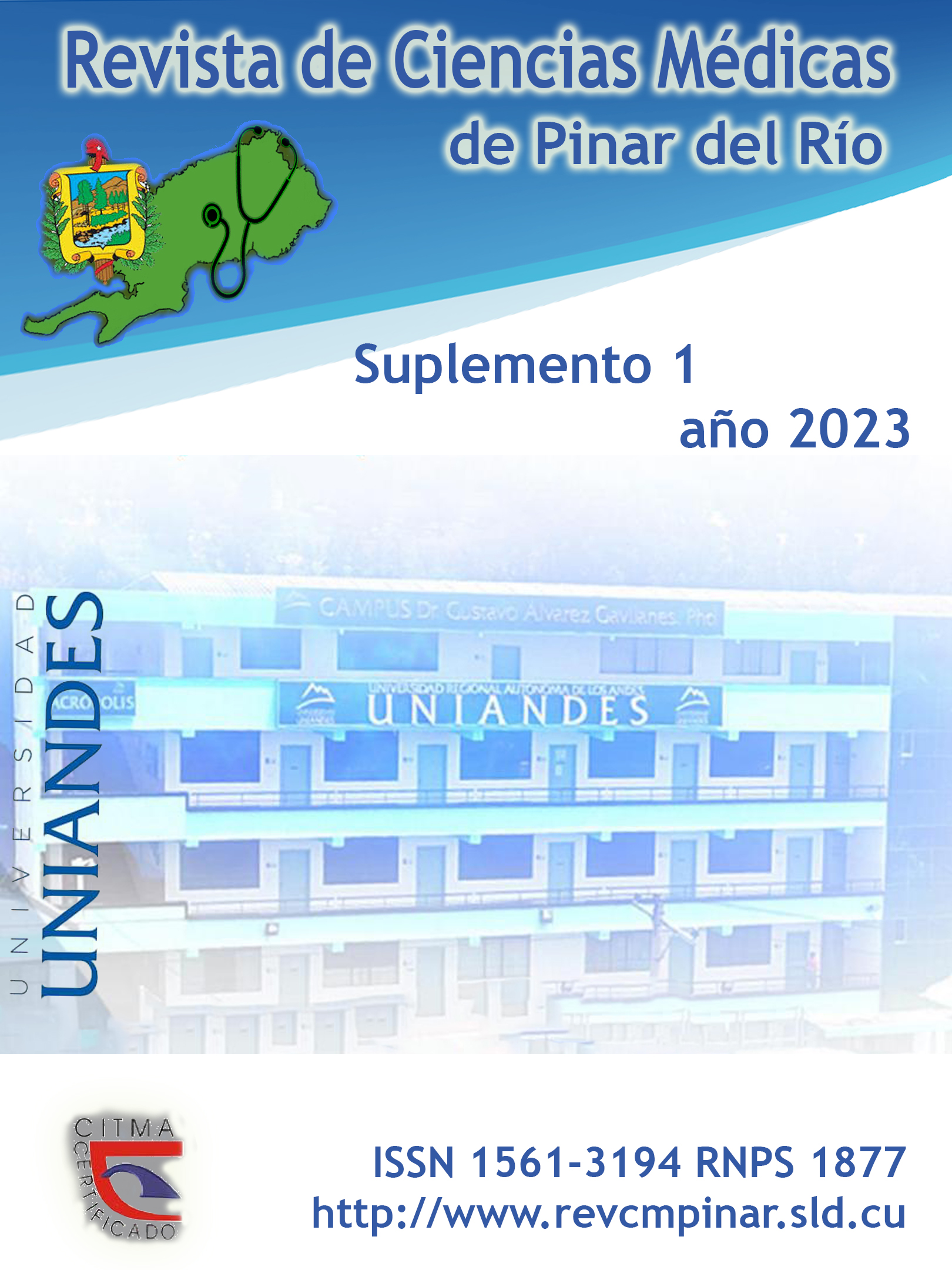Congenital dacryocele: a case report
Keywords:
LACRIMAL DUCT OBSTRUCTION, INFANT, NEWBORN, CONGENITAL, SURGICAL PROCEDURES, OPERATIVE.Abstract
Introduction: congenital dacryocele is a rare entity due to nasolacrimal duct obstruction.
Case report: female neonate, 17 days old, born after euthyroid delivery, at term, with no significant prenatal history. She presented with swelling of the right eye since birth, abundant conjunctival secretions and conjunctival hyperemia. Physical examination revealed the presence of an 8 mm diameter tumor in the area of the right lacrimal sac, not painful to palpation, bluish color. Complementary images such as ultrasound were indicated. The diagnosis of congenital dacryocele was determined. Non surgical treatment was decided. Warm compresses were indicated in the area of the affected lacrimal sac for five minutes, three times a day. It was decided to apply antibiotic therapy with tobramycin + dexamethasone in eye drops, one drop every four hours for 10 days. At the end of the treatment, the patient showed improvement, without the need of further interventions. Follow-up by ophthalmology was indicated.
Conclusions: Congenital dacryocele is a congenital entity of the lacrimal ducts of low incidence. Its diagnosis is clinical; however, imaging tests are necessary to rule out other entities. Conservative medical treatment may lead to resolution of the entity, with massage and antimicrobial therapy being useful; however, surgical intervention may be required.
Downloads
References
1. Promelle V, Demeer B, Milazzo S. Patologías congénitas en oftalmología. EMC - Pediatría [Internet]. 2020 [citado 12/10/2022]; 55(2): 1-13. Disponible en: https://doi.org/10.1016/S1245-1789(20)43831-4.
2. Simón-Campos MP, Bermúdez-Azaña KL, Gonzales-Rojas AA, Vera-Abanto MC, Sevilla-Cruz TD, Celiz-Alarcón E, et al. Dacrioestenosis con dacriocistitis aguda en lactante, a propósito de un caso. Rev Med Hered [Internet]. 2021[citado 12/10/2022]; 32(1): 42-45. Disponible en: http://www.scielo.org.pe/scielo.php?script=sci_arttext&pid=S1018-130X2021000100042
3. Fontoba-Poveda B, Baget-Bernaldiz M, Moll-Casamitjana D, Pineda Ortega L. Dacriocistitis aguda y crónica. Diagnóstico y tratamiento. FMC - Formación Médica Continuada en Atención Primaria [Internet]. 2022 [citado 12/10/2022]; 29(7): 358-363. Disponible en: https://doi.org/10.1016/j.fmc.2021.05.006
4. Ficara A, Syngelaki A, Hammami A, Akolekar R, Nicolaides K. Value of routine ultrasound examination at 35–37 weeks' gestation in diagnosis of fetal abnormalities. Ultrasound Obstet Gynecol [Internet]. 2020 [citado 12/10/2022]; 55(1): 75-80. Disponible en: https://obgyn.onlinelibrary.wiley.com/doi/abs/10.1002/uog.20857
5. Castro PT, Matos AP, Werner H, Lopez J, Ribeiro G, Araujo E, Junior E. Evaluation of fetal nasal cavity in bilateral congenital dacryocystocele: 3D reconstruction and virtual navigation by magnetic resonance imaging. Ultrasound Obstet Gynecol [Internet]. 2020 [citado 12/10/2022]; 55(1): 141–143. Disponible en: https://obgyn.onlinelibrary.wiley.com/doi/abs/10.1002/uog.21898
6. Alfaro Juárez AM, Alfaro Juárez A, Sánchez Merino C. Dacriocele Congénito. Revista Atalaya Medica [Internet]. 2020 [citado 12/10/2022]; 17: 56-57. https://dialnet.unirioja.es/descarga/articulo/7889119.pdf
7. Alfonso LS, González OF, Aranguren LV, Pereira BG. Presentación de un caso con quistes dermoides orbitarios bilaterales y múltiples. Archivos Argentinos de Oftalmología [Internet]. 2022 [citado 12/10/2022]; 21. Disponible en: https://www.archivosoftalmologia.com.ar/index.php/revista/article/download/198/233
8. Llanos D, Pedraja I, Campos L, Armijo J, Ávila LF. Radiología en las tumoraciones palpables del paciente pediátrico Parte 1. Radiología [Internet]. 2022 [citado 12/10/2022]; 64(6): 552-565. Disponible en: https://doi.org/10.1016/j.rx.2022.08.002.
9. Promelle V, Fortier M, Milazzo S. Aspects cliniques sensoriels et moteurs des syndromes de rétractions congénitaux : syndrome de Stilling-Duane et syndrome de Brown. Journal Français d'Ophtalmologie [Internet]. 2017 [citado 11/11/2022]; 40(5): 414-421. Disponible en: https://doi.org/10.1016/j.jfo.2016.10.015.
10. Solís AL, Rojas RI, Vigoa AL, et al. Valor del ultrasonido en el diagnóstico de los tumores del saco lagrimal. Rev Cub Oftal [Internet]. 2019 [citado 12/10/2022]; 32(4):1-8. Disponible en: https://www.medigraphic.com/cgi-bin/new/resumen.cgi?IDARTICULO=94963
11. Díaz-Montero C, Marqués-Fernández V, De la Herrera Flores P, Galindo-Ferreiro A. Abordaje del paciente con patología de la vía lagrimal. Indicaciones quirúrgicas. Rev ORL [Internet]. 2021 [citado 12/10/2022]; 12(2). Disponible en: https://scielo.isciii.es/scielo.php?script=sci_arttext&pid=S2444-79862021000200007
12. Singh S, Nair AG, Alam MS, Mukherjee B. Outcomes of lacrimal gland injection of botulinum toxin in functional versus nonfunctional epiphora. Oman J Ophthalmol [Internet]. 2019 [citado 12/10/2022]; 12(2):104-7. Disponible en: https://www.ncbi.nlm.nih.gov/pmc/articles/PMC6561039/
13. Favier V, Crampette L. Dacriocistorrinostomía endoscópica. EMC - Cirugía Otorrinolaringológica y Cervicofacial [Internet]. 2022 [citado 12/10/2022]; 23(1):1-7. https://doi.org/10.1016/S1635-2505(22)46384-5
14. Navarro-Hernandez E, Galindo-Ferreiro A. Dacriocistorrinostomía láser endocanalicular y sus modificaciones: revisión sistemática de técnicas y tasa de éxito. Archivos de la Sociedad Española de Oftalmología [Internet]. 2022 [citado 12/10/2022]; 97(12):692-704. https://doi.org/10.1016/j.oftal.2022.03.004
Downloads
Published
How to Cite
Issue
Section
License
Authors who have publications with this journal agree to the following terms: Authors will retain their copyrights and grant the journal the right of first publication of their work, which will be publication of their work, which will be simultaneously subject to the Creative Commons Attribution License (CC-BY-NC 4.0) that allows third parties to share the work as long as its author and first publication in this journal are indicated.
Authors may adopt other non-exclusive license agreements for distribution of the published version of the work (e.g.: deposit it in an institutional telematic archive or publish it in a volume). Likewise, and according to the recommendations of the Medical Sciences Editorial (ECIMED), authors must declare in each article their contribution according to the CRediT taxonomy (contributor roles). This taxonomy includes 14 roles, which can be used to represent the tasks typically performed by contributors in scientific academic production. It should be consulted in monograph) whenever initial publication in this journal is indicated. Authors are allowed and encouraged to disseminate their work through the Internet (e.g., in institutional telematic archives or on their web page) before and during the submission process, which may produce interesting exchanges and increase citations of the published work. (See The effect of open access). https://casrai.org/credit/



